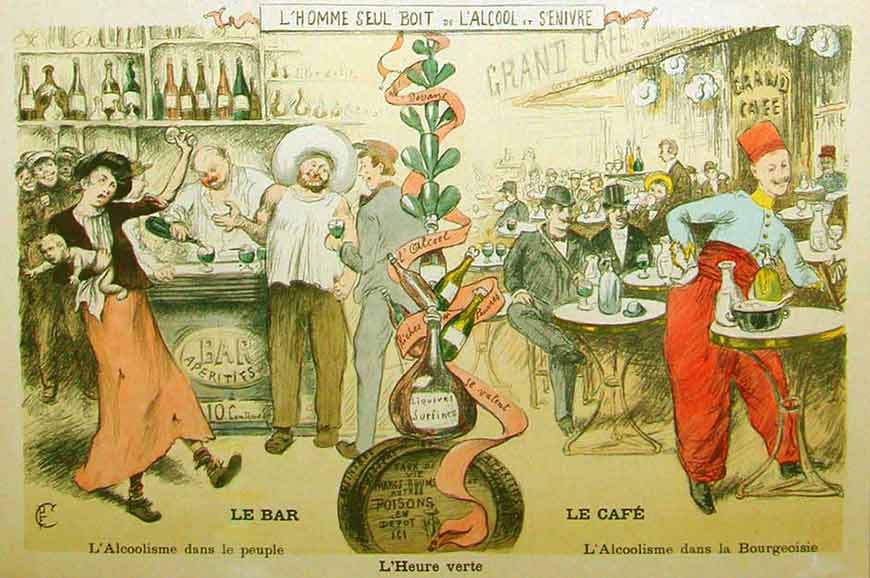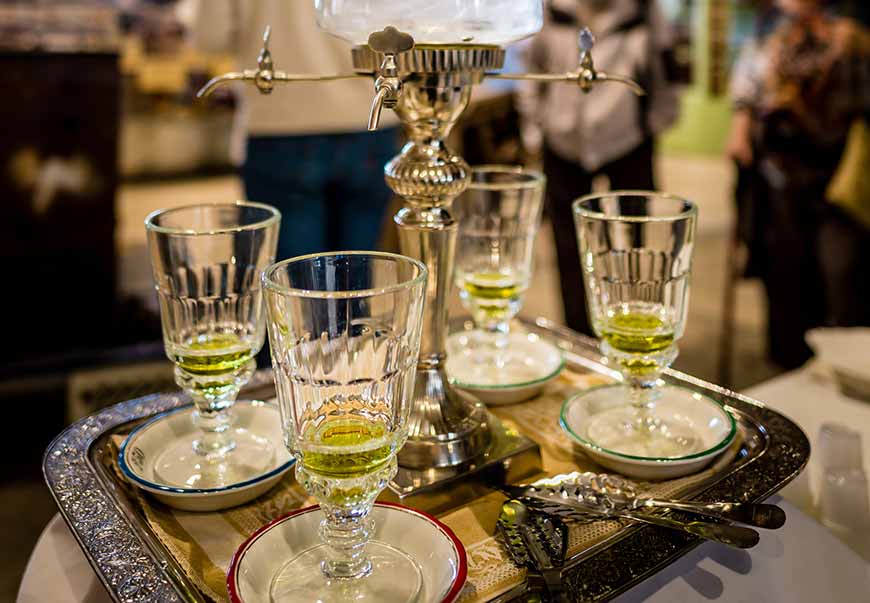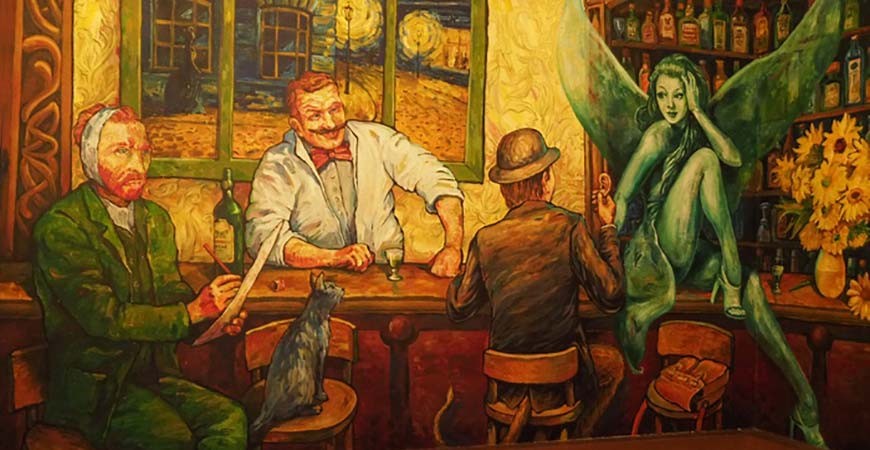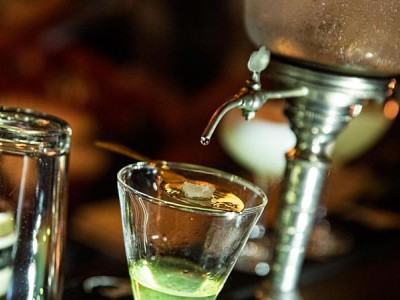Absinthe Throughout History, A Bizzare Story Hard to Believe
Absinthe Throughout History, A Story Hard to Believe
Absinthe has the most exciting story in the world of spirits. The green fairy, as it’s often called, has been many things through the ages: a cure for all maladies, a devilish drink that caused all evils, a forbidden spirit banned from entire continents, and the most prized craft beverage on the market; and that’s quite a ride, but great spirits have great histories.
Today we can enjoy a delicious glass of absinthe with ease, we are amazed by creative absinthe-based cocktails on the most prestigious bars and restaurants in the world, and we can even order it online comfortably from our homes. Don’t think for a second absinthe lovers had such an easy time enjoying the aromatic spirit in the past.
Here’s a brief history of absinthe through time, with all its ups and downs. This is the story of absinthe; a story hard to believe.
The Early Days of Absinthe
First things first, what is absinthe? And what’s all the fuzz about? Absinthe is a distilled spirit aromatized with herbs and spices, and one of its ingredients has proven to be the most controversial: wormwood.
Artemisia absinthium is an herbaceous plant native to Europe and Asia, and it has been prized since antiquity for a dark green oil it produces. Ancient Greeks and Romans used the plant to treat upset stomachs, and their knowledge passed on the early medicine men during the middle ages. They weren’t far off from the truth - Wormwood extract has active compounds, and one of them, one we call thujone, has been attributed from miraculous medicinal cures to dangerous hallucinogenic properties.
Shakespeare mentioned wormwood in Romeo and Juliet, and John Locke, the famous philosopher, was well aware of the plant’s bitterness. There’s no chapter in European history that doesn’t involve wormwood first, and then absinthe in some way or another, but it wasn’t until the nineteenth century that absinthe came to be a marketable product, and that’s where our story begins, in the Swiss town of Coviet.
An Elixir is Born
It was Doctor Pierre Ordinaire, a man that can be described as anything but ordinary, who, while experimenting with the vast diversity of plants in the green Alps, discovered the gray-hued plant known as absinthe somewhere between 1789 and 1792. A skillful distiller, he knew that the right plants could cure the sick and bring vitality back to the weak. His new potion soon got a reputation, and there, just there, absinthe became something of a legend.
Sometime, somehow, the doctor’s recipe reached the hands of the Henroid sisters who soon started providing local pharmacies with the powerful medicine. Around 1794, a skilled distiller named Abram-Louis Perrenoud, was captivated by the spirit.
Perrenoud passed the recipe to his son, Henri-Louis Perrenoud, who partnered with Daniel-Henri Dubied, a wealthy businessman, and both began producing absinthe at a larger scale at the dawn of the century. The world would soon be blazed by the spirit’s popularity.
From Medicine to Abuse
Monsieur Perrenoud established a distilling company, not before changing his last name to the more marketable Pernod. That’s when he found Maison Pernod Fils in Pontarlier, Franche-Comté, eastern France; the year was 1805.
Slowly but surely, Pernod Fils gained traction and took hold of the market, not only because of its flagship spirit, absinthe, a well-regarded healthy drink, but because not-so-sick people had found in absinthe a way to unwind.
The real boost for the company came in times of war, in 1844, during the Algerian War of Independence. The French army, looking to keep control of the African country, received daily rations of absinthe to prevent the troops from getting sick with contaminated water. The war ended in French defeat in 1847, but the French legion returned home with a newly gained taste for the anise-flavored absinthe.
Things couldn’t get better for the spirits industry as phylloxera, an American grapevine parasite, entered the country in 1863 and decimated ninety percent of European vineyards. The deadly lice cleared the path for absinth to gain the preference of the entire country, and so it did.
Cafes in Paris and all over the country served the green fairy, and everyone, every day, after working hours, gathered to celebrate the I’heure verte (the green hour) without restraint.
The Belle époque, the French Golden age, began after the Franco-Prussian War in 1871 and will forever be remembered as a time of prosperity. Social and technological innovations brought optimism, while artists and bohemians released their creativity, often with a glass of absinthe in hand.
The construction of the Eiffel Tower, the festive Moulin Rouge, the nouveau-riches sharing a table with artists like Toulouse-Lautrec and Van Gogh; the craze for absinthe expanded through Europe and reached America. Life couldn’t be better, but good times never last.

The Hard Times
The first half of the twentieth century was plagued with war, horror, and deception. Absinthe had gained a poor reputation for rising alcoholism rates, violence, and social instability.
Grape growers, on their feet again, lobbied hard against the spirit, and with the help of coincidental, alcohol-related crimes and murders, absinthe eventually got banned in Switzerland in 1910, in America in 1912 and France in 1915. The World Wars followed, and the green fairy was lost in time, did it not?
The absinthe ban didn’t reach all the corners of Europe, and countries like Czechoslovakia continued its production, becoming home of the last authentic wormwood absinthe.
It wasn’t until the 1990s when Western European countries lifted the absinthe ban, although it took a few more decades to be legal in America, in 2007, and France, in 2011, almost one hundred years after the 1915 ban.
The next absinthe revolution took place on the Internet, when pioneers like Absinthe Original, founded in 1996, began shipping real absinthe with thujone to every corner on earth, reviving the genuine spirit of the Belle époque and the traditions around the green fairy.
It’s been a lengthy ride, but absinthe is back. No one knows what the future has planned for the noble spirit, but we know good or bad, absinthe will survive it.
Absinthe is Here to Stay
As you see, absinthe is larger than life. No other spirit has such a controversial history or has been involved in so many love-hate stories. Will absinthe make you hallucinate? Probably not. Will it provoke a rampage of violence and death? Of course not. What absinthe brings to the table is a rich tradition entwined with the most important events in European history. Absinthe is drinking culture, and we can consider its craft nature an art form.

Today, absinthe is one of the greatest ambassadors for fine spirits, thanks to its timeless allure. The green fairy might seem to trend right now, but its popularity transcends time; it has always been popular, and it will always be.
Don’t miss out on being part of the beautiful world of absinthe and try it. The spirit’s mysticism will surely captivate you as you become part of its history, and it becomes part of yours.






